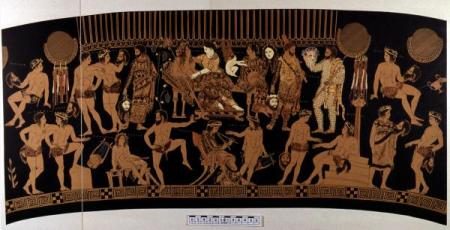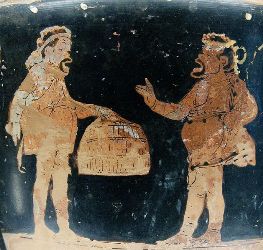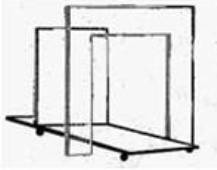

comenius

evolution of the building

changes of drama

poets - greek and roman

masks, costumes and scenery

drama as social event
 |
 comenius |
 evolution of the building |
 changes of drama |
 poets - greek and roman |
 masks, costumes and scenery |
 drama as social event |
Theatrical
masks
Masks were used in all three categories of ancient Greek theatre, that of tragedy, satiric drama and comedy. They originate from the Dionysiac feasts during which the participants used to paint their faces with the dark coloured dregs of the new wine and to decorate their heads with leaves and branches.
In ancient Greek theatre the female roles were acted by men, while the gender was also indicated by the flesh colour, white for women, dark for men.
 |
|
Members
of chorus are getting ready for the
performance. The right actor is wearing his shoes
(“kothornoi”). Near him on
the ground there is his mask. The left actor has already worn his mask.
Half of
5 cen. B.C. |
 |
|
Apulian
red-figure bell krater. Dionysus with mask & Pan with Oenochoe. |
 |
|
Scene from Aristophanes'
Birds. End of 5th. B.C. |
The mask was made of cloth dipped in gypsum and pressed on a matrix so as to obtain the desired form. Then it was covered with a thin layer of plaster and finally the features of the character were painted on it. The shape of the mask was like tat of helmet since it was covering not only the face but also the entire head. The mouth was very big as to facilitate the speech, while the opening provided for the eyes was, on the contrary, very small. Indicative of the size of the mask’s eyes is that not only the white of the eye is painted but, occasionally, even the iris itself. Characteristic element of the tragic mask was the volume, especially the upper part of the mask in Λ shape that contributed a lot to the impressive appearance of the actor.
Reconstruction
of masks for Greek tragedy by Chris Vervain, 2005 Dedicative
tragic mask of copper. End of 4 cen. B.C.
Archaeological Museum
of Pereus



Reconstruction
of mask for
Greek tragedy
Hellenistic period
During the Hellenistic period masks
obtained a strong portrait character. According to Pollux, a Roman
writer whose
writing (Onomastpicture) refers to the 3 century B.C., there were 76
types of
masks:
 |
|
Young Man with
Onkos 2nd-1st c.
BCParis, |
It is quite probable that certain
plays required the use of two masks by the hero, indicative of his
situation as
in the case of Oedipus, before and after his blindness, but this
probability
remains only a hypothesis due to the scarcity of information concerning
the
technicalities of a performance.
Tragic masks
There were six masks of old men: The oldest one was called Xyrias (character who was presented shaved in clue of bereavements). Then, comes Lefkos (White) and Spartopolios. Those three characters are personalities that suffer. The next person Melas Anir symbolizes the masculine man. The two characters that follow are Xanthos Anir (Blonde man) and Xanthoteros Anir (Blonder man). The first one appears to represent a hero, while the second one is the hero who suffers. Those two basic types of masks accompany eight young men all of them without beard and each one with different character.
 |
|
Drawings
of mask. Late Hellenistic period |
The feminine characters were also eight: Two were of big age, Polia Katakosmos (with carefree white hair) and Eleftheron Gradion (with dark hair in the length of shoulders that show that they were cut in clue of bereavements). The next five masks belong to young women while the last shows a daughter. The five young women are Katakomos Ohra (pale with carefree hair), Mesokouros Ohra (pale, with her hair cut), Mesokouros Prosfatos (with her hair cut recently), Kourimos Parthenos (the young girl with her hair cut) and Etera Kourimos Parthenos (a second girl with the same characteristics as the previous one). All the feminine characters express pain and bereavement.
 |
| TheaterMasks. c. 350 BC-100 BC
Earthenware
Modelled Hellenistic Athens. Greece. Copenhagen. Nationalmuseet |
A third team of characters is constituted by the servants called Therapontes. They are six and they have common characteristic their hairstyle (short hair) and the perikranon (a leather cap). Three of them are men, Diftherias (dressed with leather clothes), Sfinopogon and Anasimos and three are women, Oiketikon Gradion, Oiketikon Mesokouron and Diftheritis. Those masks do not represent a specific personality but present a character.
Satyr masks
Few are the information that we have
about the satyr masks. Polydeykis
reports only four. First comes Satyros Polios (the man with grey hair),
then
follows Satyros Geneion, third comes Satyros Ageneios and finally
Seilinos
Pappos. The first three satyrs differ only in the age. All of them have
wide
big noses, pointed ears of goat and slovenly hair. Only Papposatyros
has more
human form and long beard.
 |
|
Name vase of
the Pronomos painter showing Dionysos
and the cast of a satyr play. The actors are holding their masks. End
of 5 cen.
B.C. |
Ancient comedy’s masks
The masks of ancient comedy are
constituted by three teams. The first team is composed by fakes, the
second one
by portraits and the third one by imaginary creations. All masks cause
the
laughter. In contrast, those presented by girls were different,
realistic,
almost didn’t look as if they were masks. In ancient comedy
appear on the scene
contemporary people such as philosophers, poets and politicians.
Terracota
figure of an actor. He wears a mask
identified as the brother- keeper’s of the New comedy. 2th century BC, probably of Myrina, Asia
Minor.

There is
little information on theatrical costumes. This is due to the materials
they
have been made of. Still we have some information drawn from depictions
on
ancient vases.
Costumes
have been a very important factor of the production, because they could
determine the characters by gender or social status. The costumes allowed the audience
to know who the actor was trying to portray. In the
early productions actors have been using body painting. Little by
little they
started using animal skins, ears, even feathers (see
Aristophanes’ Birds).
When the poets introduced real costumes, they
imitated the contemporary dressing: the “chiton” and the
“hemateon”. The chiton
was made of linen or silk and it was worn long ( see picture below).
The
hemateon was an exterior cloth, worn over the shoulders. It was usually
made of
wool. Both chiton and hemateon were decorated depending on the
occasion. For
theatrical use the clothes have been more decorated than usually.
Fragment of a
vase of Tarento. An actor, who wears
chiton and Thracian boots , is holding a
mask. 4 cen. B.C. Wurzburg, Museum Martin von Wagner

 |
|
Phlyax
scene: master and a thieving slave? Side A
from an Apulian red-figured bell-krater, ca. 380 BC–37BC |
In
order to play female roles, since the actors were always men, they were
wearing
a “prosterneda” (in front of the chest, to imitate female
breasts) and
“progastreda” in front of the belly.
The actors used to put on ordinary shoes, such us loose fitting boots and laced boots. In some scholars’ opinion, the actors used shoes with high heels (“kothornoi”). We cannot be sure about that, because we do not have a clear evidence from the pottery. In the later years (2nd century BC), it is sure that these shoes with high heels (“kothornoi”) have been introduced.
Theatrical machines
The
permanent facade of the scene was used to hide the stage properties and the machinery.
Several types of machines were used in ancient drama.
Periaktoi: Drama was set
before a temple or a palace. To
indicate a change of scene, the periaktoi were
introduced. Periaktoi were three-sided
prisms—each side painted to represent a different
locality—, put on the left
and right side of the scene. Turning around their axon, they changed
the
background of the scene.
 |
| Periaktos |
The Aeorema: It was a crane by which the gods were appearing on the scene (deus ex machina). Evidence for the use of it in the 5th century is given in the comedies of Aristophanes. A character in his play Peace ascends to heaven on a dung beetle and appeals to the scene shifter not to let him fall. In the time of Euripides it was used for the epilogue, at which point a god descended from heaven to give an end to the complications in the plot, a convention that became known as deus ex machina(“god from a machine”).
 |
| Aeorema |
The Ekkyclema: a wheeled-plattform was used to display the
results of offstage actions, such as the bodies of murder victims
(because a
murder or a suicide never took place in front of the spectators).
The ekkyklēma,
like the periaktoi, was an expedient for open-air theatre, in
which
the possibilities for creating realistic illusions were limited.
 |
 |
| The Ekkyclema | The Ekkyclema |
A
realistic picture of an interior scene under a roof could not be shown.
So the
Greeks in order to represent the interior of a palace, for example,
wheeled out
a throne on a round or square podium.
New
machines were added in the Hellenistic period, by which time the
theatre had
almost completely lost its religious basis. Among these new machines
was the hemikyklion, and the stropheion,
which were put on orchestra. The revival of thunders and thunderclaps
was made
by vronteion, a machine behind the stage, and keraunoskopeion, a
machine on the
roof of the stage.
The
haroneia klimaka was a chthonic
corridor, a way down to the world of deads, by which chthonic gods and
eidola
of dead people were coming up.